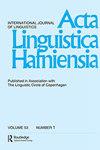在浪漫中重温完美/偏爱的不稳定性。论分叉路径的功能动机
Q2 Arts and Humanities
引用次数: 2
摘要
完美/优越对立的一个特点是其不稳定性;完成时往往会变成其他东西,比如一般过去时。在本文中,我以40个罗曼语变体为例,根据基于用法的语法化理论来讨论这种不稳定性。该数据集说明,在一个系统中,两者都存在的可能结果是完全展开或优选展开。最后,我将根据形态句法变化的动机来讨论这些发现,特别是加工过程在这些变化中所起的作用。我将根据源导向解释和目标导向解释之间的区别,简要地讨论这种变化的结果。分析表明,需要对“完美”的发展方向进行更细致的理解。本文章由计算机程序翻译,如有差异,请以英文原文为准。
Revisiting Perfect/Preterit instability across Romance. On functional motivations for diverging paths
Abstract A hallmark of the Perfect/Preterit opposition is its instability; perfects tend to become something else, such as general pasts. In this article, I employ a sample of 40 Romance varieties to discuss this instability in the light of usage-based grammaticalization theory. The data-set illustrates that either Perfect or Preterit expansion is the likely outcome of a system in which both exist. Ultimately, I discuss these findings in the light of suggested motivations for morphosyntactic change, specifically the role processing plays in these. I briefly discuss the result of the change in the light of the distinction between source- and target-oriented explanations. The analysis uncovers a need for a more nuanced understanding of the assumed direction in the development of Perfects.
求助全文
通过发布文献求助,成功后即可免费获取论文全文。
去求助
来源期刊

Acta Linguistica Hafniensia
Arts and Humanities-Language and Linguistics
CiteScore
0.90
自引率
0.00%
发文量
5
 求助内容:
求助内容: 应助结果提醒方式:
应助结果提醒方式:


